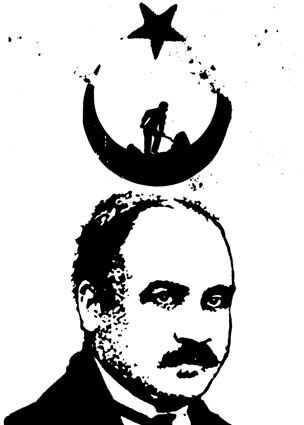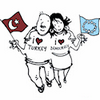Turkish nationalism is a puzzling enigma, which may be manifest on the level of its main protagonists.
After some considerations on the mystery of the nascent Turkish nationalism, Hans-Peter Geissen examines what could have been the real scope of a notion like ethnicity under the Ottomans...

The Ottoman sultans used various titles and qualities to describe (emphasize) themselves, including such like « (K)Han » (traditional for Turko-Mongol leaders), « Cesar » (the same, but following Roman imperial tradition), conqueror, warrior or defender of (Islamic) faith, provider of justice, and/or of wealth, and similar, hardly differing in style from any rulers of the times. Here, administrative practice rarely refers to ethnicity as such, though it may acknowledge « tradition » as a legitimate source of legal regulations, which may refer to ethnic traditions among others. As a direct reference for their views on people and « nationality », Ottoman censuses refer to the religious affiliation of their subjects, insofar as they are assigned to officially acknowledged creeds.
An ottoman triumvirate
Heath Lowry recently (2003) argued that Osman, the founder (actually rather Uthman) was the primus inter pares of some triumvirate of local NW-Anatolian warrior chiefs together with Köse Michal (« Bald Michael », a Bythinian Greek) and Evrenos Bej, probably the son of a Catalan-crusader-then-Byzantine-mercenary. In their later years the two joined Islam. Their descendants, then the Turkish (?) noble families of Mihailogullari and Evrenosogullari, remained prominent Ottomans for some centuries. The three were later complimented by a certain Turahan, probably a Turkic tribal chieftain or raider-knight in the same region, hence resulted a quadrumvirate according to a Byzantine source, and another « -gullari » family later.
At that point of the actual founding process of the emirate, which in hindsight was a nascent empire, neither ethnicity nor religion was a determinant. The Ottoman family inherited Anatolian-Turkish (Seljuk, etc.) traditions by using Arabic and Persian language for official purposes. The first principals replacing them with Turkish were the emirs of Karaman, a South-central Anatolian principality, in the 13th ct., when Turkish dialects had become the predominant language in Anatolia, but « Ottoman » developed as a synthesis of Turkish, Arabic, Persian and some Greek til the end of the empire. It may appear as if the earliest Ottomans, still under Seljuk influence, tried to invent an illustrous Arabic genealogy for themselves as a reference of legitimate rule, for instance by using the Arabic name « Osman » instead of the Turkish « Uthman » ; whereas later, in competition with the Karamanids and the Turco-Mongol Ilhanid dynasty, they emphasized descent from the Oguz lineage of Turkic tribes.
The Ottomans might coopt prisoners of war or non-Muslim conscripts (« Kul », a quite special status with aspects of slavery and nobility), actual local and regional nobility (including members of Byzantine imperial families), or anybody tested for their ability and loyalty. Til the early 16th ct. part of the Ottoman knights was Christian. Christian auxiliary troops never disappeared completely from the Ottoman realm, though their importance greatly twindled over time. Increasingly conversion to Islam became a prerequisite for any higher state service until the process was gradually reversed again during the 19th century.
Ottoman pluralism
There are innumerable similar examples of this among leading Ottoman staff, wether the mothers of the sultans or the (grand-) vezirs, military commanders, the janissaries, other soldiers and bureaucrats, architects, or musicians, whatever. Since Mehmed the Conqueror (II.) appointed Istanbul patriarchates with specific privileges, one could say that the (Greek) Orthodox (since 1453) and Armenian Churches (since 1458) were Ottoman state churches and still the biggest landowners in the empire except the sultan himself, and responsible for some administration. Sunnitic Islam was also reformatted as a state institution. It’s leader, the sheikülislam overseeing a leading class of judges and theologists, was appointed by the sultan. The churches elected their patriarchs according to their own regulations -but the elected had to be confirmed by the sultan- and retained jurisdiction over their flock.
Besides these, autonomous dervish orders were flourishing especially in Anatolia. Two of these were of specific importance for the Ottoman court. The Mevlevije in particular in various fields of culture, the Bektashije (a « heterodox » order affiliated to the modern Alevites) as mentors of the Janissary troops.
From the beginnings, Jews were involved in the fabric of the empire, but in particular since Mehmed’s son Bayezid II. had invited the refugees from Spain in 1492 and granted privileges of self-administration. Soon they installed the very first printing office of the empire (for Hebraic script).
Ottoman centralism left little of the ancient Turkish nobility (only on local levels), while in the capital new leading classes of Greeks (Phanariots) and Armenians (Amir) (re-) established themselves since the 17th ct. besides the leading Ottoman-Turkish (Muslim) families - which were largely of Balkanic descent, but might involve Kurds, Arabs or Caucasians as well.
While ethnic pluralism was not uncommon in imperial aristocracies or bourgeoisies, Ottoman religious pluralism remained unique and exemplary on a European and even a global level (except for Mogul India).
![]() To be continued...
To be continued...

